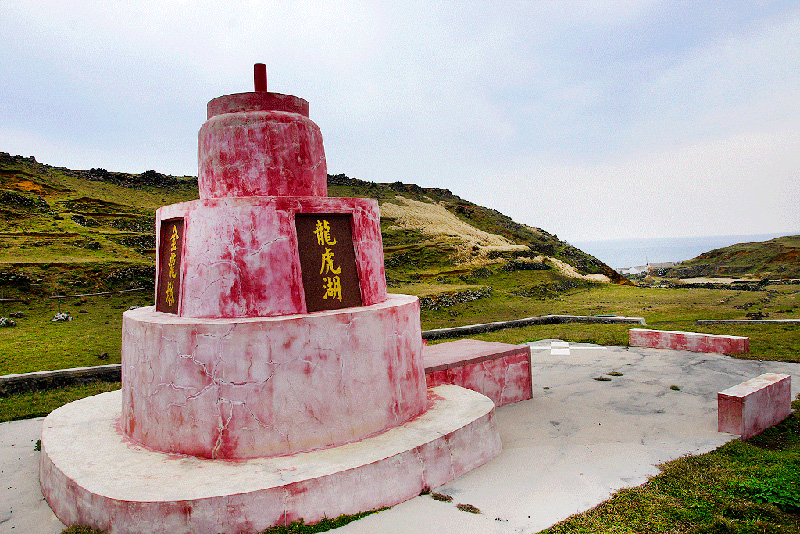Dongyupingyu
Attractions
Dongyupingyu is one of the four main islands of the South Penghu Marine National Park(*1), located in Wang'an Township, Penghu County. It lies adjacent to Xiyupingyu and is the last volcanic island to have been formed in Penghu, dating back approximately 8 million years. Situated 10 nautical miles southeast of Wang'an Islet, Dongyuping boasts of a vast coral reef coverage, an abundant marine ecosystem, and untouched land areas where traditional Penghu houses and stone wall gardens built from basalt and coral reef rock remain. The island is divided into two elongated landmasses (north and south), characterized by steep coastal cliffs encircling most of the island, winding rock veins along the northern coast, expansive sandy beaches on the southern coast and a small beach on the western shoreline.
The settlement is primarily located in the western and southwestern lowlands, with extensive stone wall gardens(*2) and terraced fields on the slopes to the north and south, creating a distinctive cultural landscape. The island has a small resident population, with tourism and fishing as its main industries. Visitors can explore attractions such as Tazi, a tied island, Frog Rock, the Dongyupingyu settlement, terraced fields and stone wall gardens, and basalt column formations. Tazi is a massive rock near the harbor that resembles Lord Guan. Composed almost entirely of exposed basalt, it has been gradually eroded by seawater and weathering, giving the surrounding rock a yellowish hue. The tied island, known locally as Sizijiao, is located along the southern coast. One side features a vast marine erosion platform teeming with intertidal organisms. Frog Rock, formed from basaltic breccia, takes on the appearance of a crouching frog. The Dongyupingyu settlement is spread across the southern, central, and northern areas of the island, with most houses built in the traditional Minnan architectural style. The settlement follows the natural contours of the hills, strategically positioned in sheltered areas to protect against strong winds. The terraced fields and stone wall gardens are situated between the two elongated landmasses of Dongyupingyu. These structures were designed to withstand the powerful northeastern monsoon, and today, their remnants stand as a testament to the island's agricultural past. The basalt column formations on the island's rear hills feature a diverse range of coastal erosion landscapes, including ocean-erosion ditches, sea stacks, and sea caves. Centered around Jinlong Tower, the left side of the area showcases a sea arch, while the view toward the ocean reveals distinctive ocean-erosion ditches. On the right, two types of basaltic joint structures—columnar and platy—were formed due to variations in magma cooling times, with volcanic breccia layers visible beneath them.
As part of the South Penghu Marine National Park, the island's resources are limited. Visitors are encouraged to respect the environment by minimizing their impact and taking all trash with them to preserve the island's delicate ecosystem.
*1: The South Penghu Marine National Park includes Dongyupingyu, Xiyupingyu, Dongjiyu, Xijiyu, and their surrounding reefs, all under the jurisdiction of Wang'an Township.
*2: A stone wall garden is a type of enclosed agricultural structure built with basalt or coral stone walls on all four sides. These walls provide wind protection, allowing crops to grow successfully.
Recommended Duration of Visit: 4 hours or overnight
Source: Penghu Travel
The settlement is primarily located in the western and southwestern lowlands, with extensive stone wall gardens(*2) and terraced fields on the slopes to the north and south, creating a distinctive cultural landscape. The island has a small resident population, with tourism and fishing as its main industries. Visitors can explore attractions such as Tazi, a tied island, Frog Rock, the Dongyupingyu settlement, terraced fields and stone wall gardens, and basalt column formations. Tazi is a massive rock near the harbor that resembles Lord Guan. Composed almost entirely of exposed basalt, it has been gradually eroded by seawater and weathering, giving the surrounding rock a yellowish hue. The tied island, known locally as Sizijiao, is located along the southern coast. One side features a vast marine erosion platform teeming with intertidal organisms. Frog Rock, formed from basaltic breccia, takes on the appearance of a crouching frog. The Dongyupingyu settlement is spread across the southern, central, and northern areas of the island, with most houses built in the traditional Minnan architectural style. The settlement follows the natural contours of the hills, strategically positioned in sheltered areas to protect against strong winds. The terraced fields and stone wall gardens are situated between the two elongated landmasses of Dongyupingyu. These structures were designed to withstand the powerful northeastern monsoon, and today, their remnants stand as a testament to the island's agricultural past. The basalt column formations on the island's rear hills feature a diverse range of coastal erosion landscapes, including ocean-erosion ditches, sea stacks, and sea caves. Centered around Jinlong Tower, the left side of the area showcases a sea arch, while the view toward the ocean reveals distinctive ocean-erosion ditches. On the right, two types of basaltic joint structures—columnar and platy—were formed due to variations in magma cooling times, with volcanic breccia layers visible beneath them.
As part of the South Penghu Marine National Park, the island's resources are limited. Visitors are encouraged to respect the environment by minimizing their impact and taking all trash with them to preserve the island's delicate ecosystem.
*1: The South Penghu Marine National Park includes Dongyupingyu, Xiyupingyu, Dongjiyu, Xijiyu, and their surrounding reefs, all under the jurisdiction of Wang'an Township.
*2: A stone wall garden is a type of enclosed agricultural structure built with basalt or coral stone walls on all four sides. These walls provide wind protection, allowing crops to grow successfully.
Recommended Duration of Visit: 4 hours or overnight
Source: Penghu Travel
Service Description:Resources on the islands within the South Penghu Marine National Park are limited. Please help protect the environment by using resources wisely and taking your trash with you when you leave. Do not add extra burden to these fragile islands.
Nearby Transportation Info
TRAFFIC INFORMATION
Transportation and Transit
INFORMATION
Visitors can hire a private boat service to reach Dongyuping.




